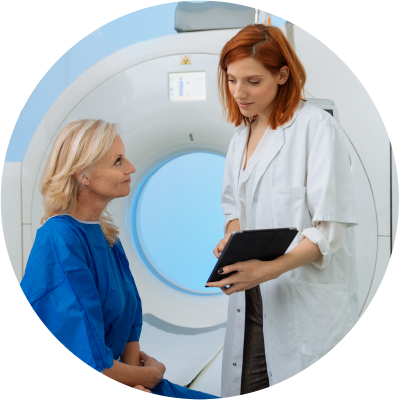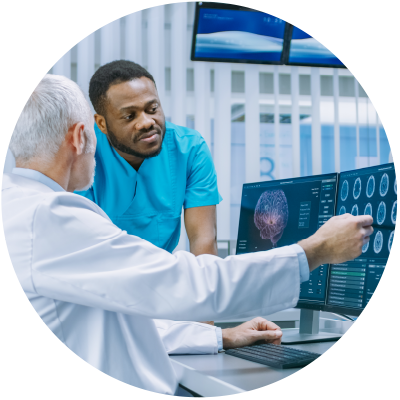Become an “RT”
Radiologic Technologist
The Radiologic Technologist program meets the American Registry of Radiologic Technologist (“ARRT”) requirements for graduates pursuing an ARRT certification. The entire program is designed to prepare students to gain the knowledge and skills necessary to operate diagnostic imaging equipment and produce high-quality medical images that can help healthcare providers diagnose and treat a wide range of medical conditions.
Studying to become a radiologic technologist involves learning about human anatomy, physiology, medical terminology, and diagnostic imaging procedures, as well as developing the technical skills necessary to operate imaging equipment and maintain patient safety. Our program further provides students this essential knowledge and skill to ensure the graduate’s future patients receive high-quality imaging services and that healthcare providers have the information they need to provide the best possible care to their patients.
Radiologic technologists play an essential role in the healthcare field. They work alongside other healthcare professionals to provide accurate and timely diagnostic imaging services to patients. By producing detailed images of the inside of a patient’s body, radiologic technologists help doctors and other healthcare providers identify the source of a patient’s symptoms, make informed treatment decisions, and monitor the progress of a patient’s recovery.
Radiologic technologists generally perform diagnostic imaging X-Ray exams, and in some cases, MRI scans, CT scans, and mammograms, on patients. Most radiologic technologists work in hospitals, clinics, and other healthcare settings, and can opt to specialize in specific types of imaging exams.
Radiologic Technologist
Job Responsibilities

Preparing patients for imaging exams
Radiologic technologists must ensure that patients are properly positioned and prepared for imaging exams, which may involve explaining the procedure, removing jewelry or other objects, and assisting with the use of contrast agents.

Operating imaging equipment
Radiologic technologists are responsible for operating imaging equipment, such as X-ray machines and in some cases, CT scanners, to produce high-quality images of the patient's body.

Maintaining imaging equipment
Radiologic technologists must ensure that imaging equipment is properly maintained and functioning correctly. This may involve performing regular maintenance and repairs, as well as troubleshooting equipment malfunctions.

Ensuring patient safety
Radiologic technologists must take precautions to ensure the safety of patients and themselves during imaging exams. This may involve using radiation shielding, minimizing radiation exposure, and following strict safety protocols.

Communicating with healthcare providers
Radiologic technologists may need to communicate with healthcare providers, such as radiologists and physicians, about the results of imaging exams and any concerns related to the patient's health.
Why a Career in Radiologic Technology?
The field of Radiologic Technology (“RT”) is growing significantly over the past decade and according to the Bureau of Labor Statistics, the field is projected to grow steadily at about 6% per year between 2021 and 2031. In addition to the growth, RT’s can pursue certifications in other modalities of imaging to continue to grow their careers. This includes obtaining further training in MRI, CT Scans, Mammography, and even Nuclear Medicine.
Radiologic Technology can
be right for you if

You Enjoy Career Stability
It is well-known Radiologic Technologists are high in demand and still expected to grow over time. This means that there is a good amount of job security and stability.

You are Attracted to Competitive Salaries
RT's are typically well-compensated for the essential work they perform. Salaries have been on the rise for RT's as the demand for medical imaging increases due mainly in part to the current aging population

You are Fascinated by Medical Technology
Even if you DO NOT have any background in medical imaging, you will be amazed at how using radiation technology can produce medical imaging essential to diagnose medical conditions

You Want a Rewarding Profession
There is nothing more rewarding in healthcare than being one of many professionals who contribute to provide a better way of life to a patient. Helping patients and contributing to their overall health and well-being by producing images, is a very specialized skill that physicians and surgeons highly rely on to make critical medical decisions.
Q&A of Becoming a Radiologic Technologist ("RT")
Do I need at least High School Diploma or GED to register in the RT program?
- Contact your local high school for information on taking the remainder of the credits needed to complete your high school education.
- Visit the GED.com site to learn more about obtaining your high school equivalency examination.
Do I need a minimum of an Associate Degree to become a Radiographer?
Yes. An Associate in Applied Science degree is the minimum level of education required to be eligible for registry examination through the American Registry of Radiologic Technologists (ARRT). Not only is it required but it also gives you the “upper-hand” when it comes to applying to desirable positions in the field. Having a minimum of an associate degree prepares you to communicate in a professional manner and enhance your abilities analyze complex situations, particularly in radiography.
Is a license required to work as RT?
This is a big yes. Unlike many other professions in the medical field, the California Department of Public Health, Radiologic Health Branch (CDPH-RHB) does issue licenses for Radiography Technologists and does require passing an approved certification exam such as one offered by ARRT. Remember that in order to qualify for the ARRT examination, the program you attend, must be completed at a college approved by ARRT.
Is NPCollege accredited or approved by ARRT?
Yes. Though we hold many accreditations and approvals from many registries for different fields, ARRT is the registry directly approved by (CDPH-RHB) for the RT program. This is one of the most important questions you should ask any college.
How long is the program at NPCollege and why do different colleges have RT programs that vary in length?
The length of any RT program depends on class schedule and thoroughness of the program. Depending on your academic history, type of completion award, and credits needed, the entire program at NPCollege can take between 19-23 months in order to fully prepare you for externship, registry testing, and future employment challenges.
Can I transfer credits from another college to take the RT program at NPCollege?
If you are in pursuit of an associate’s degree, you can transfer General Education (GE) units if those units meet the requirements our NPCollege’s GE requirements. There are no radiography classes available for transfer to the RT program unless you have graduated from another medical imaging program at NPCollege. There is also the option of challenging some of the introductory core classes. To be eligible for class challenge, you need to show evidence of field-related experience, or have taken similar classes at another institution.
Can NPCollege credits be transferred to another institution?
The transferability of credits you earn at NPCollege is at the complete discretion of the institution to which you seek to transfer to. Acceptance of the degree, diploma, or certificate you earn in your educational program at NPCollege is also at the complete discretion of the accepting Institution. For this reason, you should make certain that your attendance at NPCollege will meet your educational goals.
How can I submit an application for NPCollege's RT program?
Before we look into any application, NPCollege does require you to schedule a meeting with the admissions office to further review your academic background, and your goals. This is important because it allows us to make recommendations for your career path with only the credits you need to achieve the coveted certification from ARRT and registrations with (CDPH-RHB) to obtain a license.
Please visit the California Code of Regulations Title 17 for additional information about Radiation Regulations.
Program Completion Time
Diploma — 22 months / 90 weeks / 2730 hours
Associate Degree — 25 months / 100 weeks / 2955 hours
Get Started Today!
By clicking Submit, I expressly authorize National Polytechnic College to contact me regarding educational services via email, telephone or text at the email address and phone numbers provided. I understand this is not required to attend National Polytechnic College. MSG & Data rates may apply. Message frequency may vary. To unsubscribe reply STOP and to get assistance reply HELP. Find our Privacy Policy at https://npcollege.edu/privacy-policy